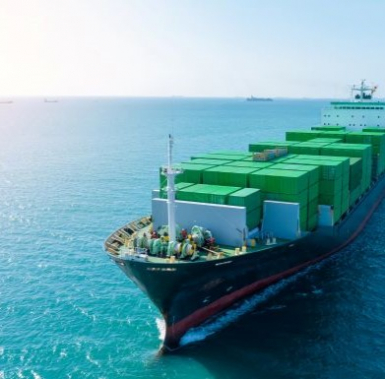FUNDING OPPORTUNITY
This call is part of the umbrella “Maritime Decarbonisation” thematic call for proposals. The objectives of this subtheme are to develop new services that support the decarbonisation of the maritime sector through digitalisation and logistics optimisation.
Digitalisation and decarbonisation are inherently intertwined. As shipping companies pledge to adopt fuel-efficient routes to align with carbon emission reduction targets, digital fleet management systems must continuously evolve and leverage real-time data. Whether addressing vessel performance, sea conditions or remote maintenance, digital technologies can play a pivotal role in empowering the shipping sector to stay competitive and sustainable.
This sub-theme includes the following topics and the specific use cases detailed in the annex. Bidders can propose additional services, not listed below, that contribute to maritime decarbonisation through digitalisation and logistics optimisation.
- Just-in-time (JIT) arrival platforms/services allow ships to optimise their speeds to arrive at a port or piloting station in a timeline that guarantees a berth, throughway or service. JIT can prevent “hurry-and-wait” patterns reducing fuel consumption and emissions.
- Predictive Maintenance: IoT sensors and data analytics can enable predictive maintenance of ship engines and equipment. By detecting potential failures before they occur, maintenance can be scheduled proactively, minimising downtime and optimising engine efficiency, thus reducing emissions.
- Optimised Route Planning: Digital tools can analyse weather patterns, currents, swell, waves, and traffic to identify the most fuel-efficient routes. By optimising routes, vessels can reduce fuel consumption and emissions.
- Dynamic Under-Keel Clearance: Routes are planned to ensure vessels maintain sufficient under-keel clearance for a safe journey, considering environmental conditions during the voyage. This clearance guarantees an adequate water depth beneath the ship for a secure transit.
- Ship Performance Monitoring and Optimisation: Digital solutions allow real-time monitoring of ship performance, including fuel consumption, engine efficiency, hull efficiency (i.e. biofouling management), and emissions. By analysing this data, operators can identify areas for improvement and optimise vessel operations to reduce emissions.
- Emission Tracking and Reporting: Digital platforms can automate the tracking and reporting of emissions, helping maritime companies comply with environmental regulations and standards. By providing accurate data on emissions, companies can identify opportunities for emission reduction and demonstrate their commitment to sustainability.
- Energy Management Systems: Implementing digital energy management systems can optimize onboard energy consumption by coordinating power generation, storage, and distribution. This ensures that energy is used more efficiently, reducing overall fuel consumption and emissions.
- Implementation and monitoring of carbon trading schemes in line with the Emission Trading System (ETS).
VALUE OF SPACE
Satellite technologies and data have a significant role to play within the proposed services:
- Satellite Positioning and timing: SOLAS Regulation V/19.2.1.6 requires all ships - irrespective of size - to have a receiver for a global navigation satellite system. Most logistics and digitalisation services rely on ships’ GNSS as the sole positioning data input. Additionally, GNSS reflectometry can be used to derive sea state for smart routing solutions, and advanced GNSS (e.g. RTK) may be used for high accuracy applications such as autonomous systems.
- Satellite Communications: Satellite connectivity is central to maritime decarbonisation and autonomous shipping. Satellite communications allow ubiquitous real-time connectivity securing a ship-to-shore channel and underpinning data analytics applications. In addition to generic VSAT, IoT, and LEO mega-constellation connectivity solutions, satellites also deliver maritime specific services such as the GMDSS, and satellite AIS, and VDES.
- Satellite Earth Observation: SatEO is routinely used to improve situational awareness on maritime operations including sea state, weather conditions, or hazards such as the presence of ice, which will be used as actionable input for maritime decarbonisation. SatEO is also used to assess the environmental impact of ships and ports, as well as to monitor fuel supply chain.
WHAT WE LOOK FOR
We look for promising business ideas addressing topics of relevance or related areas that propose:
- attractive market opportunities, identified customer needs and customer engagement
- commercially-viable service concepts
- technically feasible solutions
- added value of space data or technology
- motivated teams with business, technical, and financial expertise
WHAT WE OFFER
We offer funding and support to companies, both for business case assessment and for the development of new, space-based services. Our offer includes:
- zero-equity funding*
- technical and commercial guidance
- access to our network and partners
- ESA brand credibility
- *(50-80% depending on SME Status and Member State Approval)
ESA TENDER INFORMATION
The initiative is open to the submission of proposals for Feasibility Studies and Demonstration Projects:
- Feasibility Studies - which provide the preparatory framework to identify, analyse and define new potentially sustainable services
- Demonstration Projects - dedicated to the implementation and demonstration of pre-operational services
HOW TO APPLY
Register your team on esa-star Registration today. If your team is made up of more than one company or organisation, each entity will need to register.
Scroll down to the ‘Downloads’ section of this webpage to download the official documents. Official documents include an Activity Description (including the scope of the call, procurement approach…), an Annex (including relevant use-cases), and other supporting materials (e.g. webinar slides, if applicable)
Download the Activity Pitch Questionnaire template and submit your pitch as instructed in the Activity Pitch Questionnaire guidelines, through the online form.
ESA will evaluate your pitch. Teams whose pitches are positively evaluated will be invited to prepare an Outline Proposal and then a Full Proposal. Teams must obtain a Letter of Authorisation from their respective National Delegation before submitting a Full Proposal. Contact details of all National Delegates can be found here: National Delegation(s).
AUTHORISATION OF FUNDING
For this call, companies residing in the following Member States will be eligible to apply: Austria, Belgium, Czech Republic, Denmark, Estonia, Finland, France, Germany, Hungary, Ireland, Italy, Lithuania, Luxembourg, the Netherlands, Norway, Poland, Portugal, Romania, Slovenia, Sweden, Switzerland and the United Kingdom.
Teams can involve non-European entities, but their contribution to the activity cannot be funded by ESA. Authorisation of Funding letters from the corresponding National Delegations are required as part of the application.



